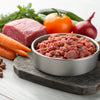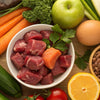How Much Raw Food Should My Dog Be Eating? A Comprehensive Guide
- Houndsy
Table of Contents
- Introduction
- Understanding Raw Diets for Dogs
- Determining the Right Amount of Raw Food
- Feeding Variances Based on Breed and Size
- Transitioning to Raw Food
- Importance of Monitoring Nutrition
- Conclusion
Introduction
As pet owners, we often find ourselves deep in thought about our furry friends’ diets. Recent studies have highlighted that over 60% of dogs are overweight or obese, which can lead to severe health issues. This alarming statistic reinforces the importance of understanding our dogs’ nutritional needs. Feeding our dogs the right amount of food is essential, particularly when it comes to raw diets that are gaining popularity among health-conscious pet owners.
In this blog post, we will dive into the essentials of raw dog food: specifically, how much raw food should your dog be eating. We’ll explore the fundamental principles of raw feeding, how to calculate the amount based on various factors, and the importance of adjusting portions based on your dog's unique needs. By the end, we want you to feel empowered to adjust your dog's diet to not only meet their health requirements but also enhance their overall well-being.
We encourage you to reflect on your dog’s current feeding routine. Are you ensuring they are getting the right amount of nourishment? Throughout this guide, our goal is to instill both confidence and inspiration as we navigate the world of raw feeding together.
Understanding Raw Diets for Dogs
What is a Raw Dog Food Diet?
Raw dog food diets are based on the premise that dogs thrive on a diet closer to what their ancestors consumed—fresh, uncooked meat, bones, fruits, and vegetables. This approach contrasts sharply with the common processed kibble, which often contains additives and preservatives not native to canine diets.
A raw diet typically contains the following components:
- Meat: Muscle meat, organs, and bones.
- Fruits and Vegetables: Certain raw fruits and veggies, which can provide vitamins and minerals.
- Supplements: Omega fatty acids, probiotics, and digestive aids can also be added to create a balanced meal.
Benefits of Feeding Raw
Switching to a raw diet can provide numerous benefits, including:
- Improved Coat Health: Many pet owners report shinier fur and improved skin health.
- Better Digestion: Raw diets often lead to smaller, firmer stools.
- Increased Energy Levels: Owners notice their pets become more active and alert.
- Weight Control: With proper portion control, raw feeding can help maintain an ideal weight.
Safety Considerations
While raw feeding has many benefits, it's essential to ensure the food is sourced correctly. Make sure to always follow safe handling procedures and consult with your veterinarian to avoid potential health risks associated with raw diets, such as contamination.
Determining the Right Amount of Raw Food
Factors Influencing Feeding Amounts
The amount of raw food your dog requires can vary based on several factors, including:
- Body Weight: Generally, dogs need to eat about 2-3% of their ideal body weight daily. For example, a 50-pound dog may require approximately 1 to 1.5 pounds of food per day.
- Age and Life Stage: Puppies typically require more food—4-6% of their current body weight—to support growth.
- Activity Level: Active dogs will require higher amounts, while less active dogs should have their portions reduced.
- Health Status: Dogs with medical conditions may have specific dietary needs and should be assessed individually.
General Feeding Guidelines
Adult Dogs
For adult dogs, the general recommendation is to feed them 2-3% of their ideal body weight daily:
- Small Breeds (under 20 lbs): May need more per pound of body weight.
- Medium Breeds (20-60 lbs): Ranges from 2-3% of their body weight.
- Large Breeds (70 lbs+): Generally closer to 2-2.5% of their ideal weight.
For example, here’s a quick breakdown:
- A 10-pound dog might eat about 3.2 to 4 ounces of raw food daily.
- A 50-pound dog will require about 1 to 1.5 pounds.
Puppies
Puppies require 4-6% of their current body weight due to their fascinating growth spurts:
- A 10-pound puppy should eat approximately 6 to 10 ounces daily, divided into multiple meals throughout the day.
Using the Raw Food Calculator
To simplify determining how much raw food your dog should be eating, consider using a raw food calculator. This tool can provide a quick estimate tailored to your dog's specific information, ensuring they receive the necessary nutrients without overfeeding. Explore our raw feeding calculator here.
Feeding Variances Based on Breed and Size
Small Breeds
For toy breeds like Chihuahuas or Pomeranians, raw feeding should be approached with caution. They can be more sensitive to changes in their diet due to their small size:
- Daily Feeding Amount: Aim for about 5-10% of their body weight.
- Meal Frequency: Small dogs might benefit from being fed 3-4 times a day, with adjusted portion sizes for each meal.
Medium Breeds
Medium breeds such as Beagles or Cocker Spaniels have more flexibility in feeding:
- Daily Feeding Amount: Typically about 2-3% of their ideal body weight.
- Adjustments for Activity: Adjust upwards for active dogs to about 3-4%.
Large Breeds
Larger breeds like Doberman Pinschers or Golden Retrievers can require careful monitoring:
- Daily Feeding Amount: Around 2% of their body weight is standard.
- Potential Adjustments: These dogs may require more food, particularly if they are working or very active.
Transitioning to Raw Food
Gradual Introduction
Transitioning your dog to a raw food diet should be a gradual process to avoid digestive upsets. Here's a handy strategy:
- Start Slow: Introduce raw food into their diet slowly by mixing it with their current food. Gradually increase the raw portion while decreasing the kibble.
- Monitor and Adjust: Watch for any changes in stool quality, energy levels, and overall health. If digestive issues arise, slow down the transition.
- Consult Your Vet: Always keep an open line of communication with your veterinarian during this transition to ensure a healthy adjustment for your dog.
Common Transition Mistakes
Avoid these pitfalls when moving your dog to a raw diet:
- Too Rapid of a Transition: This can cause upset stomachs. Take your time!
- Inadequate Nutritional Balance: Make sure to include a variety of proteins, fruits, and vegetables.
- Ignoring Your Dog's Preferences: Pay attention to what your pet enjoys and fits within the raw diet parameters.
Importance of Monitoring Nutrition
Daily Check-Ins
We recommend having informal check-ins with yourself regarding your dog’s feeding routine. Observe the following to ensure your pooch is thriving:
- Weight Monitoring: Adjust food in response to weight gain or loss.
- Energy Levels: A drop in energy may require dietary adjustments.
Consultations with Experts
Consider regular consultations with your veterinarian, especially if you’re unsure about your dog’s nutritional needs. They can offer invaluable insights to help customize their diet based on health conditions, energy levels, and lifestyle.
Conclusion
Understanding how much raw food your dog should be eating is essential for their health and happiness. It requires thoughtful contemplation of their age, breed, activity level, and health status. As we’ve explored, raw feeding can deliver impressive benefits, but it’s crucial to monitor how your dog responds to dietary changes and adapt accordingly.
Reflecting on our journey into the realm of raw feeding, we hope you feel inspired and confident moving forward. Remember, every dog is unique, and their nutritional journey is, too. To enhance your pet’s feeding experience even further, consider checking out the innovative Houndsy Kibble Dispenser. It’s designed to simplify the feeding process, ensuring consistency and convenience.
FAQ
How do I know if my dog is getting enough raw food?
Monitor your dog for signs of weight gain, weight loss, and overall energy levels. Regular visits with your veterinarian can also help assess their health and nutritional adequacy.
Can I switch my dog to raw food immediately?
It’s advisable to gradually transition to avoid digestive problems. Start by mixing raw food into their regular diet and slowly increasing the raw portion.
Is all raw food safe for my dog?
Not all raw food is created equal. Ensuring high-quality, human-grade raw meat and ingredients is essential for safety and health benefits.
How do I determine my dog's ideal weight for raw feeding calculations?
Consult breed standards and discuss with your veterinarian for tailored weight recommendations.
Should I consult with a veterinarian before switching to raw food?
Yes, a vet can provide personalized advice based on your dog's specific age, health status, and dietary needs.













